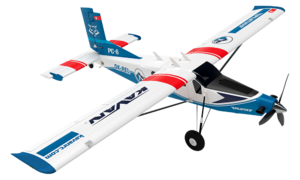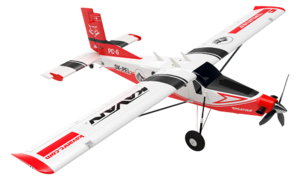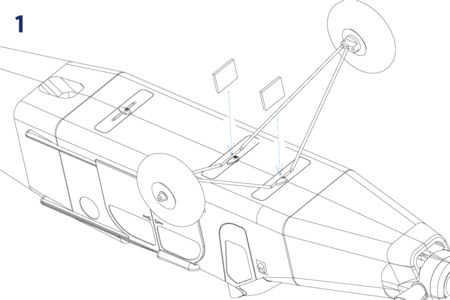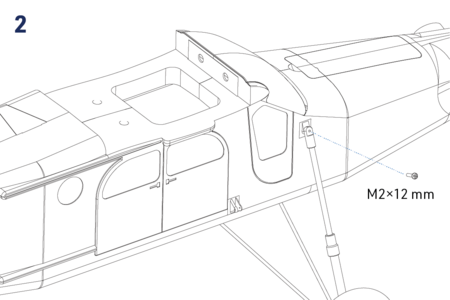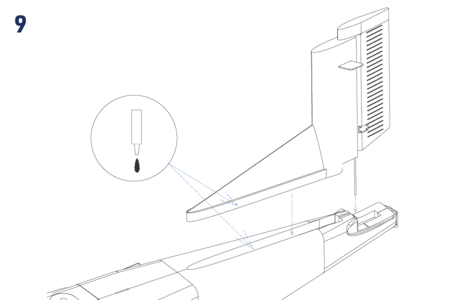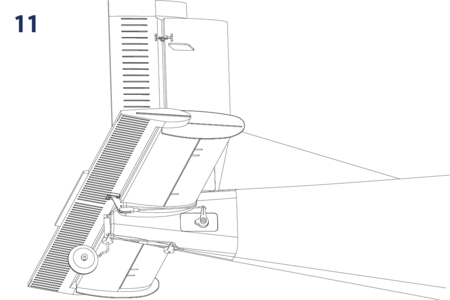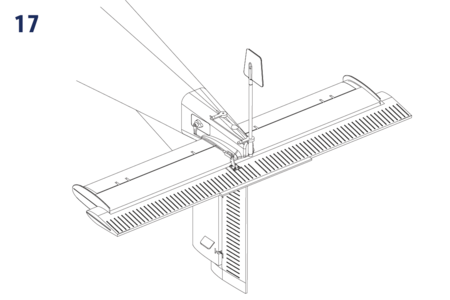KAVAN Pilatus PC-6 Porter - Bauanleitung
Einführung
Herzlichen Glückwunsch zum Kauf des Semiscale-Modells des schweizerischen Mehrzweckflugzeugs der Kategorie STOL Pilatus PC-6 Porter. Sie sind Besitzer eines nahezu unzerbrechlichen Schaumstoffmodells aus EPO (extrudiertes Polyolefin) geworden, das mit einem leistungsstarken Brushless-Motor angetrieben wird und von LiPo-Akkus versorgt wird. Jeder, der es bereits schafft, mit einem Modell mit Querrudern zu fliegen, wird das Steuern dieses eleganten Semiscale-Modells genießen!
Pilatus PC-6 Porter/Turbo-Porter
| Spezifikation (PC-6/B2-H4) | |
|---|---|
| Spannweite | 15,87 m |
| Länge | 10,90 m |
| Grundlegendes Betriebsgewicht | 1 250 kg |
| Max. Abfluggewicht | 2 800 kg |
| Max. Reisegeschwindigkeit | 232 km/h (125 KTAS) |
| Startstrecke über 15 m (50 ft) Hindernis (STOL) | 440 m |
| Landestrecke über 15 m (50 ft) Hindernis (STOL) | 315 m |
| Motor | Pratt & Whitney Canada PT6A-27 |
| Besuchen Sie https://www.pilatus-aircraft.com für weitere Informationen. | |
Das einmotorige Schweizer STOL-Nutzflugzeug Pilatus PC-6 Porter, das ursprünglich von einem Lycoming-Sechszylinder-Boxermotor angetrieben wurde, absolvierte 1959 seinen Erstflug. Bald folgte ein verbesserter Turbo-Porter mit einem Turboprop-Motor. Im Laufe der Jahre haben Turbomeca Astazou II, Garret Air Research TPE 331 und schließlich Pratt & Whitney Canada PT6A (etwa 70 % aller jemals produzierten PC-6) dieses schöne Flugzeug in den Himmel gebracht.
Unglaubliche, fast hubschrauberähnliche Kurzstart- und Landefähigkeiten haben schnell die Aufmerksamkeit von militärischen wie auch kommerziellen Betreibern erregt. Ausgestattet mit Radfahrwerken, Skiern oder Schwimmern, verrichten Porter zuverlässig und unermüdlich ihren Dienst auf der ganzen Welt - sie fliegen über Wüsten, Dschungel, Seen, Berge, Schnee und Eis - einfach überall. Kein Wunder, dass die PC-6 den Weltrekord für die höchste Landung eines Starrflüglers hält, mit einer Höhe von 5.750 m (18.865 Fuß) auf dem Dhaulagiri-Gletscher in Nepal.
Nach 604 Auslieferungen in 63 Jahren stellte Pilatus 2022 die Produktion ein…
Bevor Sie beginnen
- Falls Sie kein erfahrener Pilot sind, nehmen Sie die Hilfe eines kompetenten Piloten in Anspruch um ihr zusammengebautes Modell zu überprüfen und bei den Erststarts zu helfen. Obwohl wir Ihnen eine vollständige Anleitung zur Verfügung gestellt haben, so ist ein Modellflugzeug ziemlich kompliziert und ein erfahrener Modellbauer kann schnell ihr Modell überprüfen und somit sicherstellen, dass ihre ersten Flüge erfolgreich werden.
- Bitte bauen Sie ihr Modell genau nach dieser Anleitung auf. Versuchen Sie nicht ihren FOX zu modifizieren oder zu verändern, da dies die Flugeigenschaften negativ beeinflussen kann.
- Bevor Sie beginnen prüfen Sie den Inhalt des Bausatzes auf Vollständigkeit und prüfen Sie, dass keine Teile beschädigt sind. Dies hilft auch sich mit den Teilen des Modells vertraut zu machen. Falls Teile fehlen oder beschädigt sind, so wenden Sie sich umgehend an ihren Händler. Berücksichtigen Sie, dass ihr Händler keinen Bausatz zurücknehmen kann bei, dem mit dem Bau bereits begonnen wurde. Hinweis: Ihr Händler kann keine Bausätze zurücknehmen, wenn mit dem Bau begonnen wurde.
- Versuchen Sie zuerst die Teile zusammenzufügen bevor Sie sie verkleben. Versichern Sie sich, dass sie die korrekten Teile benutzen und dass sie gut zusammen passen vor dem Zusammenbau. Auch viel Kleber kann schlecht passende Teile nicht zurecht machen.
- Die Anleitung zeigt die Standart Einstellung des Schwerpunktes. (CG) und empfohlene Ruderausschläge. Bitte berücksichtigen Sie, dass es wesentlich ist den empfohlenen Schwerpunkt beizubehalten für die ersten Flüge, ansonsten könnte das Modell unstabil und schwer zu fliegen sein, oder gar nicht fliegen. Sie können den Schwerpunkt später tunen um ihn an ihren Flugstil und ihr Können anzupassen.
Sicherheitsmaßnahmen und Warnungen
Dieses RC-Modell ist kein Spielzeug. Benutzen Sie es mit Vorsicht und befolgen Sie die Anweisungen in dieser Anleitung genau.
Sie sich an die Anweisungen in dieser Anleitung. Bauen Sie das Modell gemäß der Anleitung zusammen. Modifizieren und verändern Sie das Modell nicht. Bei Nichteinhaltung erlischt die Garantie. Folgen Sie der Anleitung um ein sicheres und haltbares Modell nach dem Zusammenbau zu erhalten.
Kinder unter 14 Jahren müssen das Modell unter Aufsicht eines Erwachsenen betreiben.
Versichern Sie sich vor jedem Flug, dass das Modell in einwandfreiem Zustand ist, dass alles einwandfrei funktioniert und das Modell unbeschädigt ist.
Fliegen Sie nur an Tagen mit leichtem Wind und an einem sicheren Platz ohne Hindernisse.
- AEin ferngesteuertes Modell ist kein Spielzeug! Es kann erhebliche Verletzungen und Sachbeschädigungen anrichten. Fliegen Sie nur an einem sicheren Ort und folgen Sie den Anweisungen und Empfehlungen dieser Anleitung. Bleiben Sie von der Luftschraube weg! Halten Sie lose Teile entfernt von der drehenden Luftschraube, damit sie nicht eingesaugt werden können. Dies schließt lose Kleidung, und andere Sachen wie Kugelschreiber und Schraubendreher mit ein. Gehen Sie sicher, dass ihre und andere Leute Hände und Gesicht vom drehenden Propeller weg sind.
- Als Betreiber des Modells sind Sie alleine verantwortlich für die sichere Anwendung, dass weder Sie noch andere verletzt werden, oder das Modell beschädigt wird, oder Schäden an anderen Sachen entstehen. Dieses Modell wird durch eine Funk-Fernsteuerung gelenkt deren Signal durch viele Dinge gestört werden können, die außerhalb Ihrer Kontrolle sind. Diese Störungen können vorübergehenden Verlust der Steuerbarkeit zur Folge haben und es ist deshalb ratsam eine sichere Entfernung in allen Richtungen um ihr Modell herum zu haben um Kollisionen und Verletzungen zu vermeiden.
- Betreiben Sie ihr Modell nie mit schwachen Senderbatterien.
- Betreiben Sie ihr Modell immer im offenen Gelände entfernt von Stromleitungen, Autos, Verkehr, Menschen. Betreiben Sie ihr Modell nie in bewohnten Gebieten.
- Beachten Sie exakt diese Anweisungen und Warnungen. Dies gilt auch für die zusätzliche Ausrüstung, die Sie einsetzen. (Ladegeräte, wieder aufladbare Akkus, usw.)
- Halten Sie alle Chemikalien, Kleinteile und jegliche elektrischen Teile außerhalb der Reichweite von Kindern.
- Feuchtigkeit verursacht Beschädigungen der Elektronik. Vermeiden Sie Wasser-Kontakt aller Teile, die nicht dafür ausgelegt oder dagegen geschützt sind.
- Das Modell ist mehrheitlich aus Kunststoff hergestellt. Es ist nicht feuerfest. Es darf nicht höheren Temperaturen ausgesetzt werden, ansonsten könnten Verformungen oder andere Beschädigungen auftreten.
Technische daten
| Spannweite | 1500 mm |
| Länge | 1112 mm |
| Gesamtgewicht | 700–770 g |
| Flügelfläche | 27,9 dm² |
| Fluggewicht | 1650–1700 g |
| Motor | C3548-750 |
| Regler | KAVAN R-40SB SBEC |
| Luftschraube | 10×6” 3-blade |
Set inhalt
100% zusammengebautes Modell, das nur eine kurze Montage erfordert (Servos, Brushless-Motor, Drehzahlregler, Luftschraube), Bauanleitung.
Sie brauchen zusätzlich
- Mindestens einen 6-Kanal-Sender und Empfänger, den Antriebsakku LiPo 14,8 V 2600-3300 mAh.
- Übliche Modellbau-Werkzeuge: Modellbaumesser (KAV66.770), Schraubendreher, Zangen, den Flachschlüssel Nr. 10, 1,5 mm und den 2,5 mm Sechskantschlüssel oder Schraubendreher, Schleifpapier usw.
- Kleber: mittelflüssigen oder dickflüssigen Sekundenkleber (e.g. KAV56.9952 oder KAV56.9953), Klebefüller (Silikon oder MS Polymer).
Model assembly
- Push the undercarriage into slots in the bottom of the fuselage until you hear a "Click!", slide in the plastic inserts and secure by rotating the latches.
- Secure the upper undercarriage struts using M2×12 mm screws to the fuselage (do not tighten completely).
- Secure the struts to the undercarriage using M3×10 mm screws. Apply a drop of blue threadlocker to the screws but do not tighten completely.
- Slide the wing halves onto the wing tube joiner.
- Connect the wing multi connectors to the corresponding sockets in the wing halves.
- Hook up your receiver, servos and ESC following the wiring diagram (Fig. 6). The receiver is to be secured with a strip of double-sided foam tape or hook-and-loop tape to the rear part of the cockpit. Deploy the antennas so their active parts are square to each other (if you are using a receiver featuring diversity aerials).Note: The kit is supplied with the connection board for ailerons, flaps, rudder and LED lights so you can use even the most basic 6-channel radios to control your PC-6 Porter. If you intend to use independent control of aileron and flap servos and an advanced computer radio, you have to bypass the connection board accordingly.
The LED lights are only powered via the connection board; they are not remote-controlled in any way. - Attach the wing to the fuselage and secure by the wing joiner plate and two M6×40 mm plastic bolts.
- Attach the wing struts and secure them with two clips each.
- Trial the fit of the horizontal and vertical tailplane and the fuselage - no glue yet. Double check the parts fit tight and the fin is vertical to the horizontal stabilizer. If necessary sand the parts to fit. Once satisfied, apply medium or rather thick cyano (or clear silicone or MS polymer glue) to the contact area of the fin and attach the fin to the fuselage.
- Insert the horizontal tailplane in place and secure it with the M6×40 mm plastic bolt.
- Install the tail wheel and the rudder/tail wheel linkage. Do not forget to apply a drop of blue threadlocker to the setting screws.
- Attach the propeller to the prop driver and secure it with the propeller nut with a washer; tighten the nut using a No. 10 spanner. (For your safety, you should better leave the propeller installation after your radio is all connected and set and the correct direction of rotation of your motor has been tested.) Secure the spinner using an M2.5×20 mm bolt in place.
- Use medium cyano to glue the dummy antennas in place.
- Open the battery compartment hatch, and put your flight pack inside. With your radio on, set the servos to the neutral position (sticks and trims centred) and fasten the setting screws of the pushrod connectors on the elevator and rudder servo arms. Perform the throttle range calibration of the ESC as described in the attachment of this manual.
Float Set Installation (optional - sold separately) - Attach the struts to the floats and secure them with plastic braces and 2.0x10 mm self-tapping screws.
- Push the struts into slots in the bottom of the fuselage until you hear a “Click!”, slide in the plastic inserts and secure by rotating the latches.
- Install the water rudder in place. Do not forget to apply a drop of blue threadlocker to the setting screw.
RC kit installation and pre-flight check
| Recommended throws | *Low Rate | High Rate | ||
|---|---|---|---|---|
| Rate | Expo | Rate | Expo | |
| Ailerons | ±11 mm | 30 % | ±15 mm | 30% |
| Elevator | ±11 mm | 30 % | ±20 mm | 30 % |
| Rudder | ±16 mm | 20% | ±25 mm | 20 % |
| Flaps | Take-off: -10 mm down / Landing: -22 mm down | |||
- Referring to the instruction manual of your radio, carefully hook up the on-board electronics.
- Once everything has been correctly connected, turn on your transmitter and plug in the flight pack. Check the neutral positions and throws of all control surfaces. If you need to make the control surface throws smaller, simply move the pushrod closer to the centre on the servo arm or move it far from the control surface on the control horn. And vice versa.
- Aileron → Rudder: 12 mm left rudder at full left ailerons, 12 mm right rudder at full right ailerons
- Aileron differential: 15 mm up aileron/8 mm down aileron
- Flap → Elevator: 1 mm down elevator for take-off flaps, 2 mm down elevator for landing flaps setting.
- Check the direction of rotation of the propeller. If it is incorrect, simply swap two of the three wires between the ESC and motor or program the ESC (refer to the ESC manual).
- Check the correct position of the centre of gravity (CG): 56–60 mm behind the leading edge of the wing (Fig. 18). Adjust the CG position by moving the flight pack - if you cannot reach the recommended position, do not hesitate to add an appropriate amount of lead to the nose or tail. An extra couple of grams won’t spoil the flying characteristics - but the incorrect CG position is a killer.
- Fully charge your flight pack and transmitter batteries, check the proper function of your radio and perform the range check of your radio according to its instruction manual. The range has to be almost the same with the motor off and at full throttle (no more than a 10% decrease is acceptable). DO NOT try to fly unless the range check is 100% successful.
Flying
The test flying and fine-tuning is pretty much straightforward. There will be no surprise for a medium-advanced pilot who is supposed to fly this model.
"Sea" Porter
It is a good idea to test-fly your Porter with the wheels first just to make yourself familiar with your new model. Explore the safe take-off and landing approach speed, and learn to use the flaps. Once the floats are installed, check again the CG position; adjust the battery position and/or add ballast if necessary.
For the first test flights, seek an open area of calm water. Try to avoid lakes surrounded by tall trees causing turbulence above water. Tall trees would also force a dangerously steep climb right after your model gets into the air. Choose a fine day with a gentle breeze - the take-off is easier when there are small waves than from a glass-still lake.
Prepare the model as usual and check the RC set and power systems are working properly. Place your model in the water, pull the elevator up and gently open the throttle to taxi away from the bank. The model should be easy to control thanks to the efficient water rudder. Once away enough, switch the motor off, and the model will turn itself directly against the wind thanks to the "weathercock" effect of the fin.
Open the throttle and allow your model to gain speed until it rises onto the step of the floats. Leave the elevator at the neutral position; do not apply the up elevator until the model actually gains the take-off speed (a little bit bigger than with wheels). Gently apply the elevator. Do not force your model into a steep climb or sharp turn. The increased drag caused by the floats makes your Porter respond more slowly. The level flight also requires a higher throttle setting. Allow your model to climb to a safe height (50 m or so), and take your time to get the feel of your new floatplane. You should try a couple of landing approaches - at first at a safe height, and at a low level later.
However, do not get carried away by your beautiful seaplane. Remember you have to spare enough energy not only for a safe landing but also for taxiing back. Allow your model to descend steadily by keeping the throttle a little bit more open than with a land-based plane. Let your model touch down gently and smoothly on the water.
Once "docked", check if there is no water inside your model. Dry it thoroughly with a sponge if necessary. Check for any signs of damage by objects in the water and thoroughly check the water rudders.
At the end of your water flying session, carefully and thoroughly clean and dry your model from outside and inside. It is wise to carry a bottle of fresh water, a sponge and a piece of fine dry cloth with you to the lake. The exposed metal fittings might be happier if protected by a drop of WD-40 spray lube.
Appendix
Recycling and Waste Disposal Note (European Union)

Electrical equipment marked with the crossed-out waste bin symbol must not be discarded in the domestic waste; it should be disposed of via the appropriate specialised disposal system. In the countries of the EU (European Union) electrical devices must not be discarded via the normal domestic waste system (WEEE - Waste of Electrical and Electronic Equipment, Directive 2012/19/EU). You can take your unwanted equipment to your nearest public collection point or recycling centre, where it will be disposed of in the proper manner at no charge to you. By disposing of your old equipment in a responsible manner you make an important contribution to the safeguarding of the environment!
EU Declaration of Conformity (European Union)

Hereby, KAVAN Europe s.r.o. declares that this Pilatus PC-6 Porter model and the included electronic and electric devices are in compliance with the requirements of relevant European directives and harmonized norms. The full text of the Declaration of Conformity is available at www.kavanrc.com/doc/.
Guarantee
The KAVAN Europe s.r.o. products are covered by a guarantee that fulfils the currently valid legal requirements in your country. If you wish to make a claim under guarantee, please contact the retailer from whom you first purchased the equipment. The guarantee does not cover faults which were caused in the following ways: crashes, improper use, incorrect connection, reversed polarity, maintenance work carried out late, incorrectly or not at all, or by unauthorised personnel, use of other than genuine KAVAN Europe s.r.o. accessories, modifications or repairs which were not carried out by KAVAN Europe s.r.o. or an authorised KAVAN Europe s.r.o., accidental or deliberate damage, defects caused by normal wear and tear, operation outside the Specification, or in conjunction with equipment made by other manufacturers. Please be sure to read the appropriate information sheets in the product documentation.
